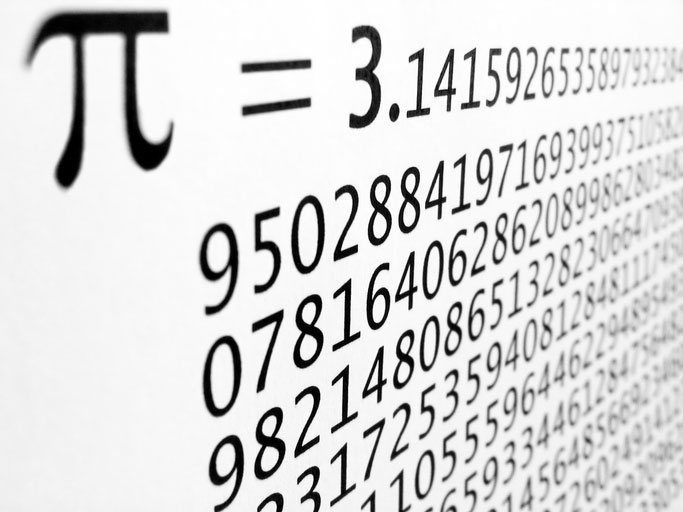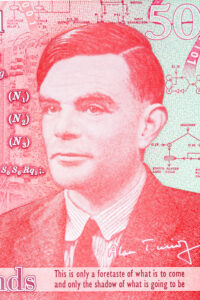

Math is described as the language of the universe, and still, it’s something that’s within the reach of any culture or person to understand mathematic fundamentals. Because mathematics is intuitive, logical, and based on observation, it’s no surprise that the story of math has been written by curious people across all of human history from a wide range of cultural and religious backgrounds. It’s a fitting subject for any well-rounded liberal arts education.
Math is the Story of Humanity’s Quest to Understand the World
The full moon is a circle… Enclose a circle with straight lines and you get a perfect square… Look at the properties of squares and circles and you come up with pi, the right triangle, sine, cosine, tangent, and degrees, and now you can make calculations that accurately predict the movement of the planets… If you measure shadows at the same time at different places you can use the properties of squares and circles to calculate the size of the earth… You can use the same geometry in the form of the parallax to calculate the distance from our sun to our nearest star system neighbors.
Math is a cumulative story written by humans, with each successive chapter building on the developments of the previous. Our most advanced technology today is ultimately a descendant of curious people staring at the full moon on a clear night, a story that’s best told from a liberal arts perspective.
The Origins of Math – A Liberal Arts Story
Humanity was born in Africa, and it’s no coincidence that math was too. A prehistoric bone tool discovered in modern-day Congo created around 20,000 years ago is a contender for being the earliest mathematical object in human history. Known as the Ishango bone, it’s a series of 168 etchings scratched into three columns on a curved piece of bone. Most agree that it’s a tally stick at the very least, used to count and keep track of numbers. Some have gone further to theorize that it was used as a lunar calendar or even to depict prime numbers.
In any case, it demonstrates that early forms of writing were used to express numerical concepts –math– even before writing was used to express spoken language.
Naturally it follows that evidence of math has been discovered among the archaeological remains of the first civilizations. Sumer in present-day Iraq spurred what’s known as Babylonian Mathematics: cuneiform script written on clay tablets featuring values such as the square root of two and studies of algebra, fractions, quadratic equations, and even the Pythagorean Theorem.
Babylonian Mathematics was a base 60 system instead of the base 10 we’re used to. That means counting was done is segments of 60. It’s thanks to the developments of Babylonian Mathematics that today:
- We count minutes in increments of 60 seconds
- We count hours in increments of 60 minutes
- We count circles in increments of 60 degrees; six total for a 360-degree circle
Ancient Egyptians used a base 10 system and had even discovered the specific concept of zero, something that eluded Babylonian Mathematics. However, the ancient Egyptian system for numbers was complicated: every number had its own hieroglyph. Writing the numbers “10” and “100” used completely different symbols, not the re-ordering of ones and zeroes that we’re used to.
It wouldn’t be until the classical period of Indian mathematics (400 AD to 1200 AD) that the numbering system we use today was invented. This included the best features from all the preceding numerical systems developed by earlier civilizations along with their own improvements:
- Base 10
- The specific concept of zero
- Positional notation: The concept that all numbers could be written with 10 characters –0, 1, 2, 3, 4, 5, 6, 7, 8, and 9– using the concept of the tens-column, the hundreds-column, the thousands-column, et cetera
During this period Islam was founded in present-day Saudi Arabia and successive Caliphates were making strides throughout the ancient world. Along with their conquests they spread the developments of classical Indian mathematicians, heralding the Indo-Arabic numeral system that we use in the present day, adopted by Europe in the Middle Ages.
Today’s mathematics in America is best expressed in a liberal arts education. These aren’t dry numbers; the development of the Indo-Arabic numeral system and advances in geometry, trigonometry, algebra, and calculus are intersectional subjects that are related to history, religion, culture, and philosophy. There’s a depth of study to mathematics that’s best addressed with a liberal arts context.
Studying Mathematics in the Context of a Liberal Arts Education Highlights Diversity in the Sciences
Normal university programs typically highlight contributions to the field of mathematics made by white European men. However, when mathematics is viewed through the lens of the liberal arts it becomes a subject that is multicultural and diverse.
Ptolemy
During the Roman rule of Egypt in the second century AD, Claudius Ptolemy wrote mathematical volumes (notably the Almagest) considered to be highly influential among Western European, Byzantine, and Islamic science. While his books are still held in high regard today, the person responsible for editing his work and making it widely available is often lost to history.
Hypatia of Alexandria
And that person was the Greek philosopher and mathematician Hypatia. Raised in Egypt, she was a renowned teacher, mathematician, philosopher, and librarian in the fourth century AD. However, in a turn of history the liberal arts is all too familiar with, she was a woman of science ahead of her time, and was brutally murdered by a religious mob.
In a time of destruction and destabilization, Hypatia undertook an invaluable mission to preserve as many classical mathematical works as she could, additionally adding her own commentary and insights.
While the historical link in the evolution of mathematics typically extends from the Classical Civilizations to the modern day, what’s often left out of the textbooks is the mathematical discoveries that took place in the pre-Columbian Americas.
Pre-Columbian America
 Much of what we praise today as the Indo-Arabic numeral system was invented independently by the Mayans and other Mesoamerican cultures in present-day Central America. The Mayans were one of the first civilizations to come up with a definitive concept of zero. They were also early adopters of positional notation, a simplified method of writing numerals. The Mayans used a base 20 system of counting.
Much of what we praise today as the Indo-Arabic numeral system was invented independently by the Mayans and other Mesoamerican cultures in present-day Central America. The Mayans were one of the first civilizations to come up with a definitive concept of zero. They were also early adopters of positional notation, a simplified method of writing numerals. The Mayans used a base 20 system of counting.
The highly developed mathematics of the Mayans enabled them to make some of the best astronomical calculations of their time, calculations that were more detailed and advanced than any of their European contemporaries.
Recognizing Diversity in Mathematics Just Means Giving Credit Where It’s Due
 Some of the mathematical concepts preserved by Hypatia in fourth-century Northern Africa withstood the test of time and, passed on through history by successive civilizations and cultures, made an appearance in the 20th century with the dawn of computing.
Some of the mathematical concepts preserved by Hypatia in fourth-century Northern Africa withstood the test of time and, passed on through history by successive civilizations and cultures, made an appearance in the 20th century with the dawn of computing.
During World War Two, Nazi Germany invented the Enigma machine, a computer believed to create indecipherable encryptions that was trusted with top-secret communications.
But a number of Polish mathematicians had made progress in deciphering encrypted Nazi messages, but it wasn’t until a British man came along to formalize the concept of the algorithm and revolutionize the approach to decrypting the Enigma machine that there was a final breakthrough. Making strides where his predecessors had stalled, Turing was able to lend an immeasurable contribution to defeating the Nazis, a feat whose profound impact will never be fully known to history.
Despite his foundational contributions to the newly intersecting fields of mathematics and computing, several years after victory Turing was criminally convicted for being gay, and in desperation committed suicide.
The liberal arts pays homage to topics like history and culture which is why it’s the perfect lens to view the history of mathematics. And the same holds true for how the liberal arts values diversity, under-represented populations, and the struggle for the disadvantaged to gain an equal footing and basic human rights.
The Age of AI is an Exciting Time to Study Mathematics as Part of a Liberal Arts and Sciences Program
 Turing is also considered to be the founder of artificial intelligence and theoretical computer science, two fields that exist because of mathematics and represent the future’s exciting developments.
Turing is also considered to be the founder of artificial intelligence and theoretical computer science, two fields that exist because of mathematics and represent the future’s exciting developments.
The famous Turing test is the benchmark guide for evaluating whether or not artificial intelligence has reached a human level. Today there’s a strong debate among philosophers, ethicists, and religious leaders about what constitutes consciousness; a debate that has important implications for the development of general artificial intelligence and wider implications for the liberal arts.
AI is thought to possibly represent the next paradigm shift in human evolution, potentially marking the boundary of our species between being a carbon-based life form, to perhaps being a silicone-based one. This is all thanks to the concept of algorithms that were fleshed out by Turing, who himself stood on the shoulders of mathematicians tracing a lineage back all the way to Hypatia and beyond.
Computing and AI is just one of the exciting branches of mathematics. Others include the modeling of the fundamentals of our universe, the quanta, in String Theory, and the application of mathematical principles to generate actionable information based on petabytes of data about every individual on earth, as statistical analyses are applied using data science in realms like surveillance, advertising, and propaganda.
Today mathematics has an impact on the lives and reality of everyone, and it’s going to become even more influential going into the future, making it a perfect subject to include in a liberal arts education.





